Stelvio Is the SUV That Thinks It’s a Race Car
By John Gilbert
Discussing driving characteristics of new cars is the major part of any car review. Then along comes the Alfa Romeo Stelvio Quadrifoglio, and reasonable discussion goes right out the window.
Alfa Romeo always deserves a gold star for building cars that capture your senses, in ways that can be flat-out fun, even without going flat-out, literally. When Alfa Romeo decided to re-enter the U.S. market a few years ago, its designers set out to build a fantastic flagship sedan, and it was the Giulia. I’ve driven it both in rear-wheel drive and in all-wheel drive, and with both the 2.0-liter 4-cylinder and the 2.9-liter V6. As I wrote at the time, it is the best-handling sedan I’ve ever driven.
Shortly after the Giulia’s introduction, Alfa Romeo decided that to be fully competitive, it also needed an SUV, and we can all thank the powers that be that Alfa decided to take a shortcut, basically building an SUV body atop the Giulia sedan platform and drivetrain.
Spending a week with a 2019 Alfa Romeo Stelvio Quadrifoglio, identifiable as the top model by the neat little white cloverleaf on either side of the body, went beyond fun. That cloverleaf stands out especially on the accompanying paint job, which is “Rosso Competizione Tri-Coat.” In the best interests of Italian car-painting passion, I think it means red, or more accurately competition red.
What sets the Stelvio Quadrifoglio test vehicle above the normal Stelvio is that it has all-wheel drive, and it s powered by the optional upgrade to the 2.9-liter V6. The story of that engine is worth retelling. When Fiat bought out Chrysler, forming FCA for Fiat Chrysler Automobiles, we learned a lot about the size and scope of Fiat, which owns Ferrari, Alfa Romeo, and Lancia, along with Chrysler, Dodge, Ram and Jeep. Sergio Marchionne, who was chief executive of Fiat, FCA and all the affiliates, was the one who guided the Giulia through to completion.
Once it was finished, a beautiful sedan from every angle, he called upon the Formula 1 racing engineers from Ferrari and gave them the assignment of designing from the ground up a new and high-tech engine that would match the high standards of design and handling the Giulia had already attained. The chief engineer selected certain engineers and they hand-built the engines for the Giulia.
When the Stelvio came along, sharing the distinctive styling and the platform of the Giuglia, the very good 2.0-liter 4-cylinder was joined by the Ferrari F1 designed 2.9 liter V6, turbocharged, to deliver 505 horsepower and 443 foot-pounds of torque. From 2.9 liters! That 2.9 turbo engine causes the price of either the Stelvio or Giulia to jump $25,000 – $30,000, putting the Stelvio test vehicle up into the $90,000 range. But then, all things being equal, if you were a car fancier, having your engine built by a Formula 1 race engineer would be worth anything they ask.
For what it’s worth, the Grand Prix of Belgium was held Saturday morning, and I got up at dawn to watch it. Charles Leclerc, a Frenchman, won the race at Spa-Francorchamps in a Ferrari in an impressive performance that made me realize that when we talk about the Stelvio engine being built by Formula 1 engineers, it’s not just Formula 1 engineers, but possibly the best race engineers in the world. The Stelvio is not a race car, but you realize it’s an SUV that acts like a race car.
The starter button requires a search at first, because it’s located at the lower left corner of the steering wheel, causing you to grope around on the right for a couple minutes before you spot that large, red round button. Push it and the engine snarls to life. Engage the 8-speed automatic and the Stelvio springs to life. But you can’t settle for just that. You need to experiment with the little puck-shaped switch on the console, with which you can click to normal, eco, comfort and sport, on up to the top button, which is spring loaded, so when you click it you get the race setting.
Then you also can push down on the suspension button in the center of the mode switch and get comfort or firm, on up to race. There remains a little switch with an icon of tailpipes, and when you click that, you get the absolutely heavenly tone from that engine as it goes to full quad, which sends a major chill through the seat of your bucket-seated extreme.
Now you hit the gas and the Stelvio leaps ahead, capable of reaching 60 in a 3.3-second burst, and if you wisely selected the manual side of the shifter gate, you can upshift by clicking the long aluminum shift paddles affixed to either side of the steering column. Run the revs up and click the right one, and you get the next gear, with just a hint of the burble you want from the exhaust.
The Stelvio shifts just fine by itself, in automatic setting, but it’s just so much fun to hand shift it with the paddles, either up or down. Coming down a fairly steep hill from Duluth’s Skyline Drive to the city far below, down-shifting a couple of times holds your speed in control, and also raises the pitch and the note of that splendid exhaust.
The bucket seats are firm and well-bolstered, and the rear seat is roomy and comfortable for adults, leaving a generous storage area for luggage behind the second row seats. The luggage area has helpful little strips for adjustable tie-down locations to help secure your worldlies as you head off on a cross-country venture.
And believe me, the Stelvio will provoke you into making cross-country trips as often as possible, and you may look for as many curvy roads all along the way.
The word “Stelvio” is named after a village and mountain pass in South Tyrol in the Italian Alps, known for its tightly twisting highway. Appropriate, I’d say, because the Stelvio not only would flash through that pass with grace and speed, but it would sound other-worldly doing it.
The Stelvio can’t match the all-out race-car handling of the Giulia, because nothing can — including some race cars — but the Stelvio comes close, giving you an upper-class riding position on those electronically firmed-up dampers and the “race” settings on your exhaust, power delivery and shift points.
I’m not sure how the Italians do it, but the steering and the suspension in the Stelvio are so precise that, like the Giulia, the car seems always poised to react in an instant to your steering inputs
The wide, low profile Pirellis ride on 20-inch black alloy wheels that are artistic themselves, and the huge red calipers for the Brembo brakes carry the “Alfa Romeo” script. The 2019 Stelvio adds Apple CarPlay and Android Auto connections for 2019, and boasts all the newest safety electronics, such as remote start, stop-start at stoplights, full speed forward collision warning and rear back up camera for blind-spot and cross-path detection, park assist, and there is a hill-descent control and heated wipers, mirrors and headlight washers.
From a driving standpoint, you’ll appreciate the active suspension and the torque-vectoring differential, and you may be impressed to know it has a carbon-fiber driveshaft, and carbon-fiber also is used for interior trim on the dashboard and console.
An 8.8-inch screen on the dash relays navigation and audio controls, and a 7.0-inch color cluster display augments that. The audio system is Harmon Kardon and fills the cabin with sound, although changing frequencies remained a challenge for us as the week went along. We didn’t really care, because unless there was a good ballgame on, our top alternative was to shut it off, and open the windows to hear those two-stage quad pipes bark.
High-performance bi-Xenon headlights and LED taillights and accent lights give you a light show whenever you turn on the lights, or leave the automatic setting for high and low beams. The driver assistance package adds lane-departure warning and adaptive cruise control with adaptive following.
The Stelvio options lifted the price from $80,245 to $96,540 with all the Quadrifoglio trim and features — a staggering amount if you’re used to normal midsize SUVs, but another one of those vehicles that performs better and quicker than any other SUV you might be interested in. Maybe you can find one that handles as well, although I’m doubtful.
And I am sure you won’t find another SUV that produces the exhaust sound thrills of the Stelvio Quadrifoglio.
Anyone who has been able to experience an assortment of the current breed of SUVs can attest to the fact that there are countless new models that exceed your highest hopes. But not all of them are fun. Some are roomier, but no more comfortable. Some can tow more than the 3,000 pounds listed for the Stelvio, but I don’t know if I’d want to tow anything with it, let alone more.
If you could line up a half-dozen of your final candidates, all in a row, for a final examination, just don’t make your choice without starting the Stelvio and clicking the exhaust to make use of the “dual” part of the dual-mode quad exhaust. Heck, if you were wealthy enough you might want to buy a Stelvio and set it up on a treadmill outside your screen window so that you can start it up and hear that heavenly sound remotely.
Tragically, Sergio Marchionne died from complications of surgery about a year ago. I’ve met him and talked to him several times at car introductions. And I would love to ask him if he believes the Ferrari Formula 1 engineers met their assigned task to build an engine as good as the rest of the Stevio. I’m also pretty sure I know the answer.


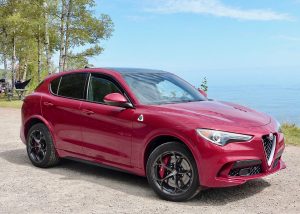
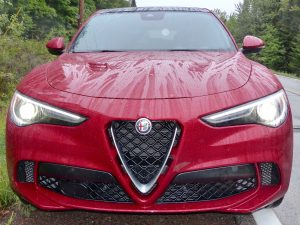
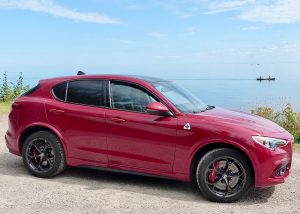
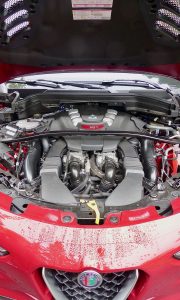
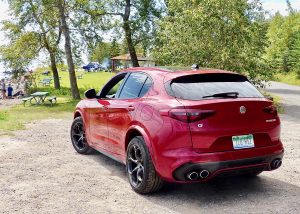
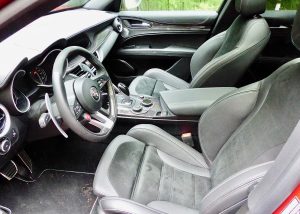
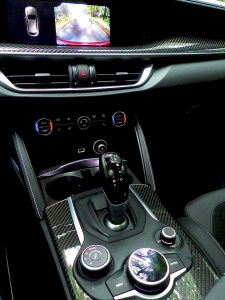
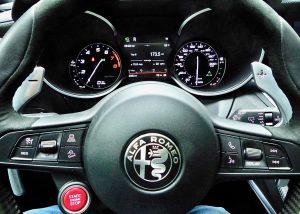
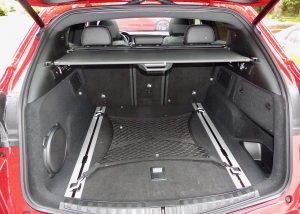
 John Gilbert is a lifetime Minnesotan and career journalist, specializing in cars and sports during and since spending 30 years at the Minneapolis Tribune, now the Star Tribune. More recently, he has continued translating the high-tech world of autos and sharing his passionate insights as a freelance writer/photographer/broadcaster. A member of the prestigious North American Car and Truck of the Year jury since 1993. John can be heard Monday-Friday from 9-11am on 610 KDAL(www.kdal610.com) on the "John Gilbert Show," and writes a column in the Duluth Reader.
John Gilbert is a lifetime Minnesotan and career journalist, specializing in cars and sports during and since spending 30 years at the Minneapolis Tribune, now the Star Tribune. More recently, he has continued translating the high-tech world of autos and sharing his passionate insights as a freelance writer/photographer/broadcaster. A member of the prestigious North American Car and Truck of the Year jury since 1993. John can be heard Monday-Friday from 9-11am on 610 KDAL(www.kdal610.com) on the "John Gilbert Show," and writes a column in the Duluth Reader.